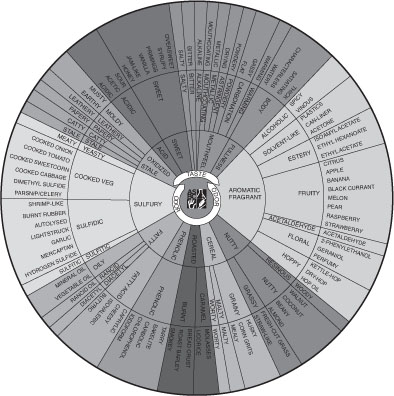Flavor Wheel is an internationally accepted tool that describes in a graphical wheel format the flavor terminology of beer. It serves to standardize the terms used in descriptive analysis of beer and enables brewers to communicate effectively about flavor. The original wheel named and described 122 separately identifiable flavor notes (in 14 classes) that can occur in beer. The system was developed from 1974 to 1979 by a joint working group consisting of the Master Brewers Association of the Americas, the American Society of Brewing Chemists, and the European Brewery Convention and stems largely from the input of the late sensory evaluation scientist Dr Morten Meilgaard.
On the wheel each separately identifiable flavor characteristic has its own name; similar flavors are placed together and no terms are duplicated for the same flavor characteristic. The goal is to provide a reference standard compound to be used in spiking (titrated dosing with flavor-active or aroma-active compounds) of beer samples to convey the meaning of each term. This aids in the training of sensory panelists.
From the simplified figure of the wheel it can be seen that the inner portion consists of 14 classes of components. As an example, Class 1 is aromatic, fragrant, fruity, and floral. The first tier then represents the more specific flavors that appear within that class. Class 1 is broken down into alcoholic, solvent-like, estery, fruity, acetaldehyde, floral, and hoppy descriptors. A four-digit code is also applied to those descriptor terms. The class and first-tier terms contain common terminology familiar to most people and thus form a vocabulary to fulfill nonspecialist needs. A second tier, not shown in the figure, further refines the flavor notes and becomes more specific and specialized. For example, the term “estery” from the aromatic/fragrant class (Class 1) is subdivided into distinct esters such as iso-amyl acetate, ethyl acetate, and ethyl hexanoate. The other second-tier terms are also subclassified into the distinct flavor notes within the respective groups. Additionally, components are also classified into more diversified physical odor, taste, mouthfeel, warming, and after-taste/flavor sensations.

Flavor wheels graphically represent the flavors found in beer and standardize the terminology used to describe beer flavor. reproduced by permission from the american society of brewing chemists, st. paul, mn
As terminology and understanding of beer flavor components grow, so, ideally, does the Beer Flavor Wheel. Recently collaborative committees are redefining the wheel to include more aged/oxidized beer flavors, the concept of mouthfeel, and newer, more style-specific flavor components. The time may have come to split up the wheel into several subwheels to better define the new terminology.
